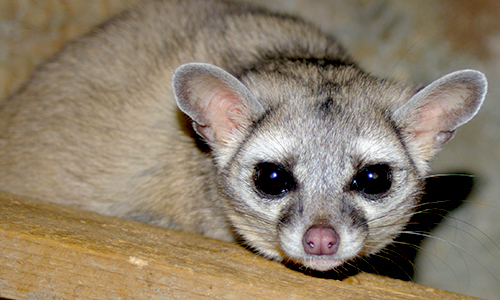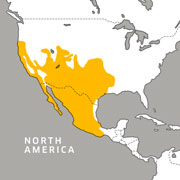Ringtail
Bassariscus astutus

About the Ringtail

Geographic Range:

Class: Mammalia
Order: Carnivora
Family: Procyonidae
Genus: Bassariscus
Species: astutus
Ringtails have a cat-like body and fox-like face with large oval ears, bushy ringed tails, and semi-retractable claws. Ringtails are excellent climbers, and they can maneuver quickly and agilely among cliffs and ledges by ricocheting from wall to wall. They can also climb in small crevices by chimney stemming (pressing all four feet on one wall with their back against the other). Scent is as important as sound for communication among ringtails. If captured, a ringtail will emit a high-pitched, penetrating scream and excrete a pungent, foul-smelling secretion from its anal glands.
Ringtail Facts
Most Closely Related to:
The ringtail is part of the family Procyonidae which includes other small omnivores such as the raccoon and the coati. The genus Bassariscus, comprises only two species, the ringtail and its closest relative, the cacomistle. There are five subspecies of cacomistle (Bassariscus sumichrasti variabilis, Bassariscus sumichrasti sumichrasti, Bassariscus sumichrasti oaxacensis, Bassariscus sumichrasti notinus, and Bassariscus sumichrasti latrans).
Appearance:
The ringtail's upper body is tan in color with some darker hair, and its underparts are a pale buff. The tail is bushy and has black and white rings (hence the common name of the species). The eyes are ringed by black or dark brown and set within tan patches. Ringtails have a cat-like body and fox-like face with large oval ears land semi-retractable claws. Ringtails have 40 teeth, with well-developed canines.
Size:
- Weight: 1.8 to 3.0 pounds (males tend to be larger than females)
- Length: Head and body: 12 to 16.5 inches; tail: 12 to 17 inches
- Shoulder height: about 6 inches
Diet:
Ringtails are omnivorous, but they prefer to eat animal matter. Specific dietary items are selected by seasonal availability or abundance. Animal matter usually consists of rodents, rabbits, squirrels, and insects. Birds, lizards, snakes, frogs, and carrion are also eaten. Plants and fruits are also eaten, and when available, ringtails may even feed on nectar.
Reproduction:
Both male and female ringtails reach sexual maturity near 10 months of age. Breeding typically occurs at the end of February and females give birth in May. Female ringtails have a single estrous cycle in a season, usually lasting 24-36 hours. Gestation ranges from 51 to 54 days. Birth usually occurs in May or June, with the litter size ranging from one to five cubs, with three being average.
Females choose a den in a rock crevice or tree hollow to give birth. Babies are born small (approximately 25 grams) and underdeveloped. Neonates open their eyes around one month of age. Juveniles will start to eat solid food at 30 to 40 days and are weaned at 10-12 weeks. The mother is responsible for care, teaching her young to forage beginning around 2 months of age. The father is sometimes tolerated and may play with cubs as they grow older.
Behavior:
Ringtails are solitary creatures, except during their breeding season. They are nocturnal, with some crepuscular (twilight) activity. Much of their time is spent foraging for food and grooming. Ringtails are excellent climbers, and they can maneuver quickly and agilely among cliffs and ledges by ricocheting from wall to wall. They can also climb in small crevices by chimney stemming (pressing all four feet on one wall with their back against the other). Ringtails are able to quickly and vertically descend by rotating their hind foot 180 degrees, allowing the pads of their feet and claws to retain contact with the substrate.
Adult ringtails vocalize by emitting an explosive bark, a piercing scream, and a long, high-pitched call. Infants vocalize with metallic chirps, squeaks and whimpers. When threatened, a ringtail will make itself appear larger by bristling its tail hair and arching the tail over its back towards its head. If captured, a ringtail will emit a high-pitched, penetrating scream and excrete a pungent, foul-smelling secretion from its anal glands. Scent is as important as sound for communication among ringtails. This species uses urine to scent mark its territory, rubbing urine on the ground and on raised objects. Ringtails increase their marking activity during mating season to attract a mate and deter competitors of the same sex. Tactile communication between ringtails is also likely.
Habitat/range:
Preferred habitats include shrubland, forest, rocky areas (inland cliffs, mountain peaks), desert and grassland.
The ringtail is widely distributed across the United States from southern Oregon and California through the south-western states to Texas. In Mexico, its distribution is from the desert region of the Baja California peninsula to Oaxaca. Three islands in the Gulf of California are included in its distribution: Tiburón, Espíritu Santo, and San José. The species is usually distributed from sea level to 1,400 meters above sea level, but has been documented as high as 2,900 m. Home ranges can be up to 0.5 square miles depending on the availability of food and places to hide. Males generally have larger home ranges than females, and home ranges of same-sex ringtails don't overlap.
Ringtails have been recorded in outlying states including Arkansas, Louisiana, Alabama, and Ohio. These populations are likely the result of a ringtail habit of boarding railroad cars and being transplanted.
Median Life Expectancy:
7 years
Threats:
Ringtails are legally trapped for fur in Arizona, New Mexico, Colorado and Texas, and thousands of animals are trapped each year. More are unintentionally caught in traps set for other animals such as foxes and raccoons. The trend of trapping ringtails for fur is declining due to the fur's poor quality (thin, non-durable hair that fades over time). Automobiles are also a threat to ringtails.
Fun Facts:
- Bassariscus astutus, is derived from bassar (fox), isc (little), and astut (cunning), or cunning little fox.
- Ringtails are known for their superior “mousing” skills, even better than those of cats! Ringtails were even placed in frontier mines to control rodents, earning this species the name, “miner’s cat.”
You Can Find This Animal in the Treasures of the Sierra Madre
Miner's Cats
Ringtails are known for their superior “mousing” skills, which are even better than those of cats! Ringtails were placed in frontier mines to control rodents, earning this species the name, “miner’s cat.”
Committed to Conservation
Zoo New England participates in the ringtail Species Survival Plan. By sharing research and knowledge, participating institutions work together to establish guidelines that best ensure the health of captive populations, and with success, the survival of endangered species.
You May Also Like
At Franklin Park Zoo:
At Stone Zoo:

